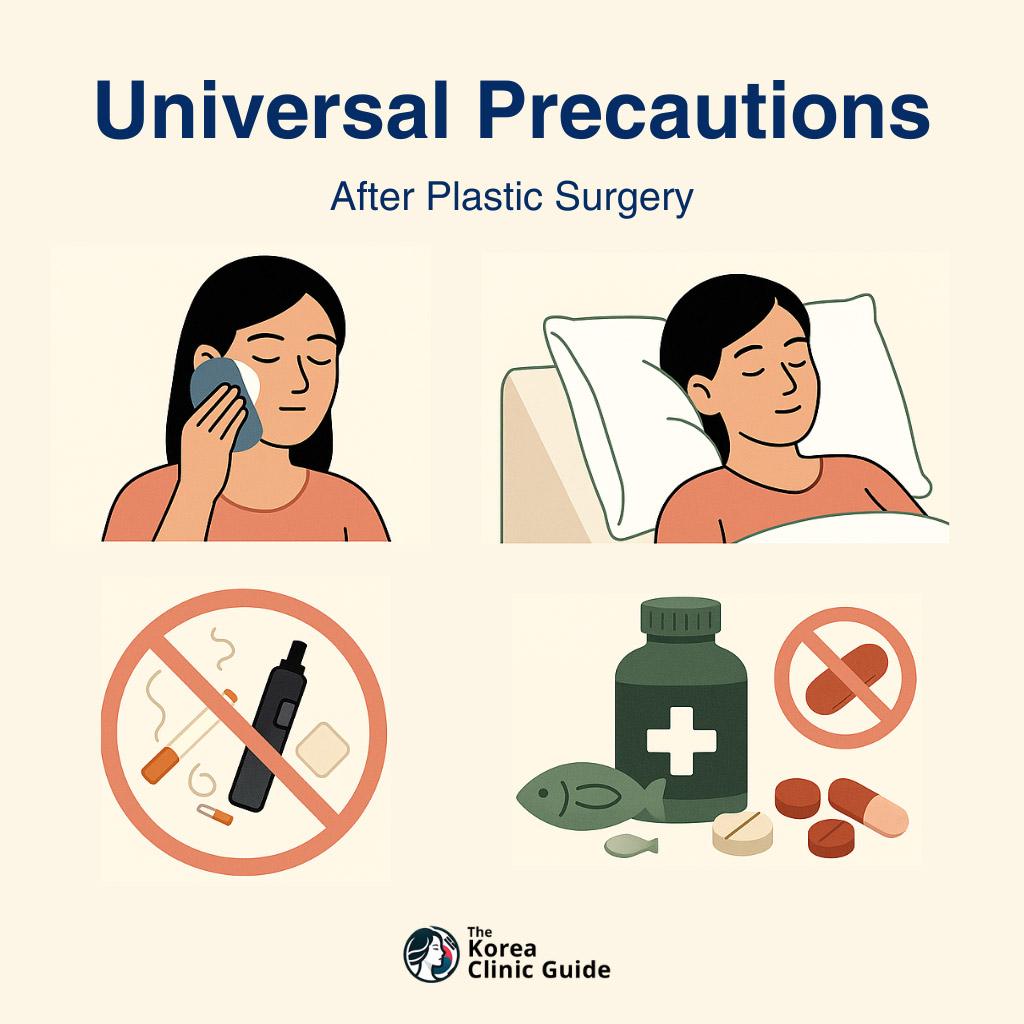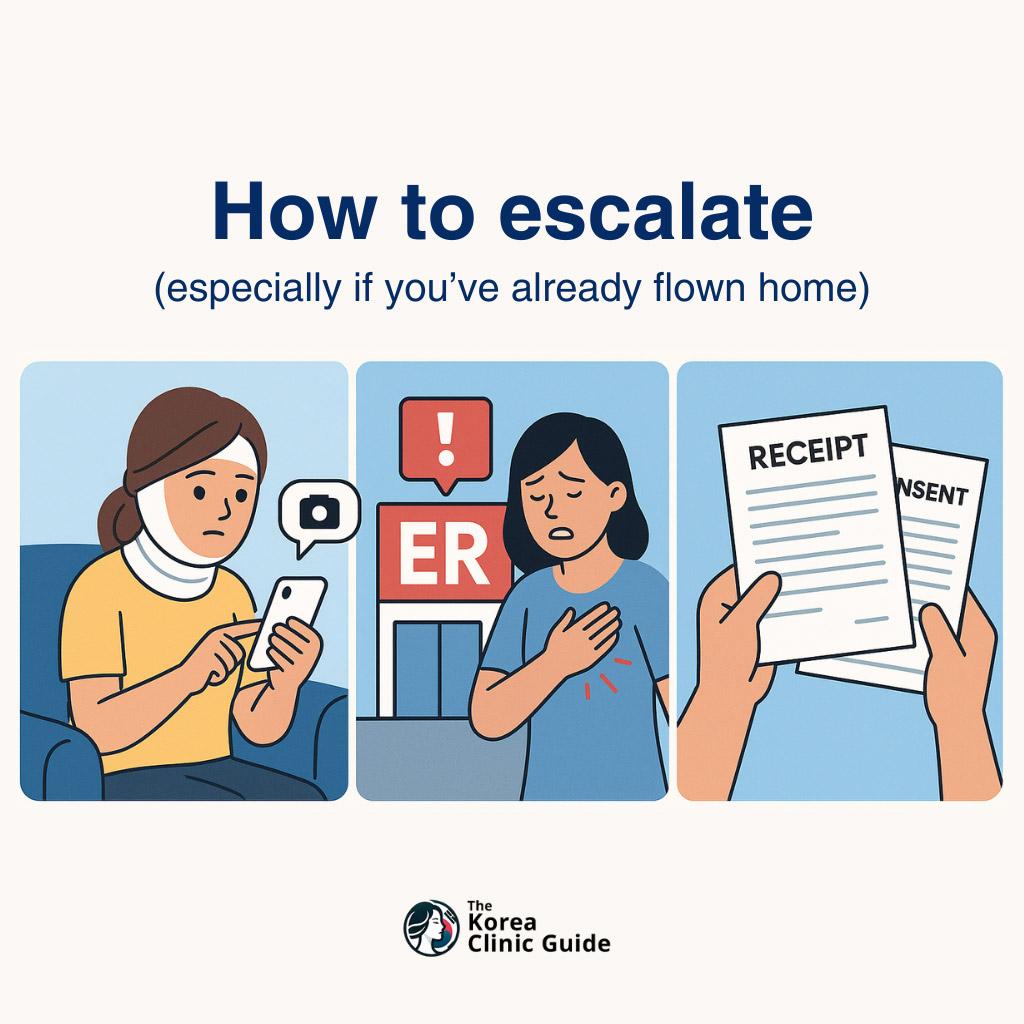Medical Tourism Blog
How Long to Stay in Korea After Plastic Surgery: Recovery Timelines, Symptoms & Precautions (By Procedure)

Table of contents
- What’s normal vs. when to worry
- Universal precautions (apply to most cosmetic surgeries)
- Procedure-specific timelines (what to expect & typical follow-ups)
- Travel & follow-up windows for visitors (rule-of-thumb)
- When to escalate (especially if you’ve already flown home)
- Conclusion
Considering treatment in Korea? Everything you need to know e.g. — how to avoid scams, visas, interpreters, recovery tips — in our Medical Tourism Master Guide. Plan with confidence in minutes, not weeks!
Medical disclaimer: Every surgeon and procedure is different. Always follow your own surgeon’s written instructions. Use the timelines below as planning guidance—not personal medical advice.
Recovery and aftercare can matter more than the surgery itself. The first days set the tone for your results, your comfort, and how soon you can fly home. In this guide, you’ll see what the immediate post-op period actually looks like (normal symptoms vs. red flags), procedure-by-procedure do’s and don’ts, and practical stay-planning tips—how long to remain in Korea, when stitches/splints usually come out, and which follow-ups you’ll need before you go.
What’s normal vs. when to worry
Common/expected (early):
- Swelling and bruising peaking at 48–72 hours, then gradually improving.
- Mild bleeding/oozing from small incisions during the first 24–48 hours.
- Fatigue, sore throat, or nausea after anesthesia (usually transient).
Call your clinic urgently (same day) if you have:
- Fever > 38.3°C / 101°F or any fever persisting >48 hours.
- Rapidly expanding swelling/asymmetry, uncontrolled bleeding, foul drainage, spreading redness, or skin turning dusky.
- Chest pain, shortness of breath, sudden leg pain/swelling (possible DVT/PE).
Universal precautions (apply to most cosmetic surgeries)

-
Sleep elevated (2–3 pillows) for the first week to reduce swelling.
-
Cold compresses in the first 48 hours, then switch to warm as guided by your clinic (face procedures).
-
No nicotine (cigarettes, vapes, gum, patches). Nicotine impairs blood flow and wound healing; ≥4 weeks of cessation is associated with fewer complications.
-
Medications/supplements to avoid before and shortly after surgery (unless your surgeon says otherwise):
Aspirin/salicylates, NSAIDs (e.g., ibuprofen, naproxen), many herbals/omega-3/fish oil, and anticoagulants/antiplatelets (e.g., warfarin, clopidogrel)—never stop prescription drugs without the prescriber’s approval.
Examples of “anticoagulants such as aspirin”: aspirin (ASA), warfarin (Coumadin), clopidogrel (Plavix)—confirm the plan with your surgeon and prescribing doctor.
-
Alcohol & saunas: avoid during the first 1–2 weeks; heat and alcohol worsen swelling/bleeding (your clinic may give a specific window).
-
Sun protection: once wounds are sealed, use SPF and avoid direct sun over scars for several months to reduce hyperpigmentation.
-
Activity: short walks from day 1; avoid strenuous exercise and heavy lifting 2–4 weeks depending on the procedure.
Air travel planning (long-haul): Many surgeons prefer 1–2 weeks (or longer) before flying after facial surgery like rhinoplasty; some hospital leaflets advise up to 4 weeks before long-haul travel after general anesthesia due to DVT risk—ask your surgeon for a personalized window. On flights >4–6 hours, hydrate, walk regularly, and consider compression stockings if advised.
Procedure-specific timelines (what to expect & typical follow-ups)
The day-by-day below harmonizes common Korean clinic routines (packing/splints, suture removal points, donor-site care) with international guidance. Your surgeon’s schedule takes priority.
1)Eye Surgery (Double-Eyelid Surgery, Blepharoplasty, Canthoplasty)
Normal: swelling/bruising peak at 48–72h; light tearing, tightness.
Usual timeline:
- POD 1–3: wound check; cool compresses; eye lubrication as directed.
- POD 5–7: suture removal for incisional upper/lower lid; inner (transconjunctival) approaches may have little/no external sutures.
- Week 1–2: bruising fades; reading/screens as tolerated.
- Week 3–6: residual swelling settles; make-up over healed incisions.
Avoid: rubbing eyes, contact lenses (ask your clinic when to resume), strenuous exercise ~2 weeks.
2)Rhinoplasty (with/without cartilage harvest from ear/rib)
Normal: stuffiness, drips, swelling, temporary numbness of tip/upper lip.
Usual timeline:
- POD 1–3: nasal packing/splints/merocel removed (if used); dressing change; ear/rib donor checks.
- POD 5–7: remove external splint/tapes and columellar sutures; retaping or skincare as directed.
- POD 7–10: remove internal stitches and ear sutures (if cartilage taken).
- POD 10–14: remaining external/donor-site sutures out (e.g., rib/scalp), gentle cleansing continues.
- Weeks 3–6: most social swelling down; avoid glasses on the bridge unless taped/splinted per clinic. Final refinement takes months.
Flight note: many surgeons advise 7–14 days before flying; longer for rib harvest/complex work—confirm with your surgeon.
3)Facelift/Neck lift (SMAS/mini/short-scar) & Brow/Forehead lift
Normal: fullness/tightness around ears/neck; numbness that improves over weeks–months.
Usual timeline:
- POD 1–2: remove drains/bulb if placed; dressing change.
- POD 5–7: partial suture removal (e.g., preauricular).
- POD 10–14: remaining sutures/staples (e.g., postauricular/scalp) out; gentle hair washing per clinic once cleared.
- Weeks 2–4: swelling/bruise fade; light exercise resumes when approved.
- Months 3–6: firmness and numb spots continue to soften.
4)Facial contouring (zygoma reduction, jaw/chin bony surgery)
Normal: significant swelling, tightness, temporary numbness; soft diet initially.
Usual timeline:
- POD 1–2: drain removal (if used), intraoral care teaching.
- POD 5–7: suture removal at external points (if any); chin strap/elastic support often maintained 1–2 weeks.
- POD 10–14: intraoral stitch removal (if non-dissolving).
- Weeks 2–4: most bruising resolves; residual swelling persists several weeks.
- Months 3–6: gradual refinement and sensory recovery.
5)Liposuction (face/body) & Fat grafting
- Face lipo: small dressings; chin strap typically off around POD 3–5 if advised; sutures by POD 3–7; mild lumpiness can last weeks.
- Body lipo: compression garment is standard—often 4–6 weeks (ask your clinic). Early walking is encouraged; avoid high-impact workouts 2–4 weeks.
- Fat grafting (face/breast/hip): protect grafted areas from pressure/ice/heat; swelling common 2–3 weeks; volume fluctuates as a portion resorbs normally.
6)Breast procedures (augmentation, reduction, lift, gynecomastia)
Normal: chest tightness, swelling; possible drains for large procedures.
Usual timeline:
- POD 1–3: dressing check; drain removal if present.
- POD 5–7 or 10–14: suture removal depending on technique; shower when cleared.
- Weeks 1–6: continuous support/garment or surgical bra; avoid arm-over-shoulder and heavy lifting until cleared.
7)Hair transplant (FUE/FUT)
Normal: scalp redness/crusting; forehead swelling peaking around day 3–4; shedding of transplanted hairs in weeks 2–4 (“shock loss”) is expected.
Usual timeline:
- 24–48h: many clinics allow gentle shampooing (pouring method).
- Days 7–14: scabs typically shed; donor area comfortable.
- FUT: suture removal around 10–14 days.
- Weeks 2–8: shedding phase; then dormancy.
- Months 3–6: new growth begins; 12–18 months for full maturation.
Travel & follow-up windows for visitors (rule-of-thumb)
Use these windows as a planning baseline, not a promise. Every surgeon’s aftercare (suture removal, packing/splint removal, garments, skincare) is a bit different. Before you book flights, ask: “What is my exact follow-up schedule, and how many days do you want me to stay?” Confirm which visit is the last medical clearance for travel and whether a video check-in is acceptable after you return home.
Full Checklist: What questions should I ask during an online consultation?
Tip: If you’re combining procedures, plan for the longer window and add a 1–2 day buffer in case your stitch-out or clearance shifts.
- Eyelids (incisional): stay 7–10 days for stitch removal and check.
- Rhinoplasty: plan 10–14 days if cartilage harvest; simple primary cases sometimes 7–10 days.
- Facelift/neck lift: 10–14 days for staged suture removal.
- Body lipo & breast: 7–14 days depending on drains/closures.
- Hair transplant: 7–14 days (FUT needs stitch removal around day 10–14).
Long-haul flight precautions: Ask your surgeon for timing; some recommend up to 4 weeks before long-haul after general anesthesia. In flight: walk hourly, do ankle pumps, hydrate, avoid alcohol, and consider compression stockings if advised.
When to escalate (especially if you’ve already flown home)
Most swelling, bruising, and mild drainage are expected—but some signs need same-day attention. If you notice rapidly increasing swelling/asymmetry, foul-smelling drainage, spreading redness, fever, severe pain unrelieved by meds, or chest pain/shortness of breath, contact your clinic immediately and follow their emergency instructions. When in doubt, go to the nearest ER first and notify your surgeon second.
For non-urgent issues (persistent discomfort, dressing questions, minor asymmetry), send your clinic a clear message with photos (front/45°/profile, good light), a brief timeline of symptoms, and any meds you’re taking. Keep all communication in writing so your team can track changes and advise you accurately—especially once you’ve flown home.

- Message your clinic/agency with photos and symptom timeline.
- If urgent danger signs (fever >38.3°C, rapidly growing swelling, chest pain/SOB, leg swelling/pain): seek emergency care immediately and notify your surgeon.
- Keep copies of estimates, consents, receipts for any insurance or dispute process later.
Conclusion
Great results come from good surgery + great aftercare. Build your trip around the actual follow-up milestones (not just your flight deals), keep your instructions and meds handy, and communicate early if something doesn’t feel right. Whether you’re here for eyelids, rhinoplasty, facelift, body work, or hair transplant, the same formula applies: know what’s normal, protect the incision, show up for checks, and escalate promptly when needed. Do that—and your time in Korea will be smoother, safer, and far more satisfying.







